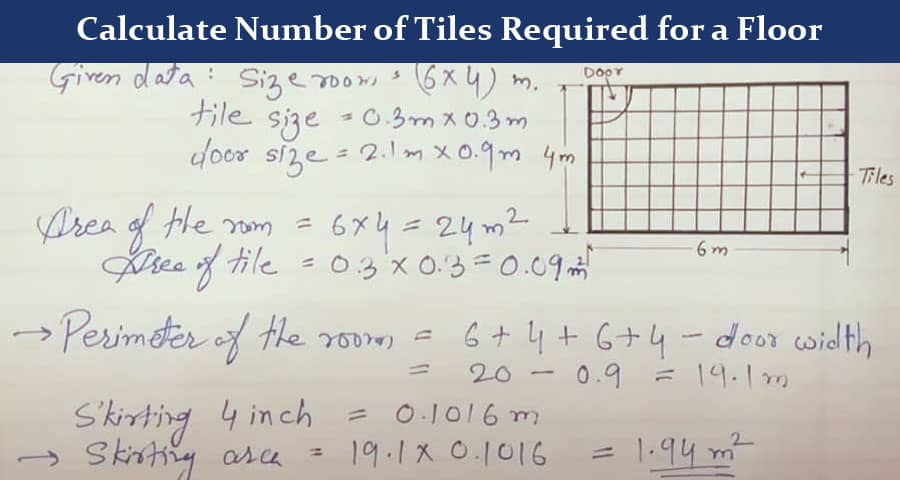How to Find Out the Number of Tiles Required for a Floor

When planning to tile a floor, one of the most crucial steps is determining the number of tiles required. Misjudging the quantity can either leave you with a shortage or excess tiles, both of which can be costly.
Step 1: Measure the Area of the Floor
The first step is to measure the area of the floor. Accurate measurements are essential for determining how many tiles you'll need. Depending on the shape of the floor, the method of calculation can vary:
For Rectangular or Square Floors:
- Measure the Length and Width: Use a tape measure to record the length and width of the floor area in meters or feet.
- Calculate the Area: Multiply the length by the width to get the total area.
Formula:
Area = Length x Width
Example:
If the length of your room is 5 meters and the width is 4 meters, the total area is:
5m x 4m = 20 square meters
For Irregularly Shaped Floors:
Irregular floors, such as L-shaped or trapezoidal rooms, require breaking down the floor into smaller sections. Measure each section individually, calculate the area for each, and then add the results together for the total area.
For Circular Floors:
If you're tiling a circular area, you need to use the formula for the area of a circle.
Formula:
Area = π x (Diameter/2)2
Example:
For a circular floor with a diameter of 6 meters:
Area = 3.14 x (3)2 = 28.26 square meters
Step 2: Determine the Size of the Tiles
Next, you'll need to know the size of the tiles you plan to use. Tiles come in various shapes and sizes, so this is a key factor in calculating the quantity required.
Common tile sizes include:
- 30 cm x 30 cm (12 inches x 12 inches)
- 60 cm x 60 cm (24 inches x 24 inches)
- 45 cm x 45 cm (18 inches x 18 inches)
Convert the dimensions into square meters or square feet for easier calculation. For instance, a 30 cm x 30 cm tile covers:
30/100 x 30/100 = 0.09 square meters
Step 3: Calculate the Number of Tiles Needed
Once you have the total floor area and the area covered by a single tile, you can determine how many tiles you need.
Formula:
Number of Tiles = Total Floor Area / Area of One Tile
Example:
If your floor area is 20 square meters and you are using 30 cm x 30 cm tiles (which cover 0.09 square meters per tile), the number of tiles required would be:
20 / 0.09 ≈ 222 tiles
Step 4: Account for Wastage
It's essential to account for tile wastage due to cuts, mistakes, or breakage during installation. A common practice is to add an additional 5-10% to the total number of tiles.
Formula:
Wastage = Total Tiles x Wastage Percentage
Example:
If you need 222 tiles and want to add 10% for wastage:
Wastage = 222 x 0.10 = 22.2 tiles
Therefore, you'll need to purchase approximately 244 tiles in total.
Step 5: Consider Tile Patterns
If you're planning to install the tiles in a specific pattern, such as a diagonal layout or a herringbone design, you may need more tiles than with a standard grid pattern. Some patterns require additional cuts, which leads to increased wastage. In such cases, consider increasing the wastage allowance to around 15%.
Step 6: Finalize Your Tile Order
After calculating the total number of tiles required and adjusting for wastage, it's time to finalize your order. It's a good idea to order extra tiles, especially for future repairs or replacements. Tiles from different batches can have slight color variations, so having a few spares from the same batch will ensure consistency in the future.
Special Considerations for Different Types of Tiles
There are several types of tiles you might consider for your flooring project, and each has its specific considerations:
Ceramic Tiles:
Ceramic tiles are commonly used due to their affordability and versatility. However, they are prone to chipping, so accounting for slightly more wastage is advisable.
Porcelain Tiles:
Porcelain tiles are denser and more durable than ceramic tiles, making them suitable for high-traffic areas. Their higher durability means less wastage, but you might need specialized tools for cutting them, which can increase wastage if cuts are not precise.
Natural Stone Tiles:
Stone tiles such as marble, granite, and slate add luxury but also come with challenges. Natural stone tiles can have imperfections, so it's essential to inspect each tile before installation, leading to higher wastage.
Mosaic Tiles:
Mosaic tiles come in small pieces that are typically pre-arranged on a mesh backing. Calculating mosaic tile quantities is more complicated, but the overall process remains the same: calculate the area and adjust for wastage.
Common Mistakes to Avoid
- Skipping the Wastage Calculation: This is a common oversight that can lead to delays and increased costs.
- Inaccurate Measurements: Ensure you double-check all dimensions before calculating.
- Not Considering Tile Pattern: Overlooking the impact of tile layout on the number of tiles required can result in a shortage of materials.
Conclusion
Calculating the number of tiles required for a flooring project doesn't have to be overwhelming. By following the steps outlined above - measuring your floor area, determining tile size, accounting for wastage, and considering layout patterns - you can ensure you have the correct number of tiles for your project. With careful planning and accurate calculations, you'll avoid costly mistakes and ensure a seamless tiling experience.
